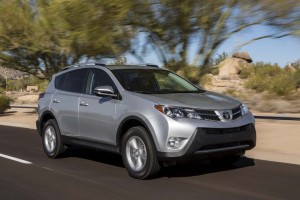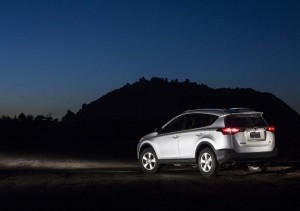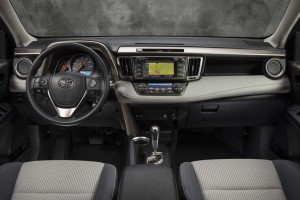Over the years, the RAV4 has been one of Toyota’s great successes. The original “cute ute,” it was one of the first crossover vehicles to connect with American customers at a time when traditional SUVs dominated the market.
But the market has changed substantially in the nearly two decades since the original Toyota RAV4 came to market and cheap and cheerful is no longer an acceptable formula. Competitors such as the latest Honda CR-V and Ford’s radically redesigned Escape have turned up the heat on Toyota by delivering much more lavish features and sophisticated design.
But during a drive of the 2013 RAV4 remake, Toyota officials – backed by the vehicle itself – made clear there’s no interest in ceding the market. “We introduced RAV4 to the U.S. market in 1995… and since then, we’ve sold more than 1.7 million with 80% still on the road today, which is a true testament to its quality and durability,” observed Toyota Division general manager Bill Fay.
A bit of time behind the wheel and it becomes apparent Toyota has noticeably improved the 2013 RAV4’s overall dynamics. On the highway, the new CUV delivers a firmer ride, has more precise steering and comes with a significantly improved suspension, indicating Toyota listened to the criticism of the previous generation vehicle.
The older model was undone by indifferent steering and brakes and so-so handling. But the problems definitely been addressed, making the new RAV4 much more fun to drive than its predecessor.
That said, while the 2013 remake is okay on dirt roads and the all-wheel-drive system can no doubt handle a moderate amount of snow, Toyota hasn’t turned the RAV4 into an off-roader. It’s still a poseur compared to the few true, trail-rated SUVs left on the market.
The 2013 RAV4 comes equipped with one of Toyota’s work horse engines, the 2.5-liter 4-cylinder familiar to fans of the Toyota family. The engine has been matched up with a six-speed automatic transmission this time, which helps bolster the vehicle’s fuel economy and delivers a respectable 176 horsepower and 172 foot pounds of torque.
The V-6 which used to be available in the RAV4 has been sent to the company’s garage and Toyota says the combination the four-cylinder engine, six-speed automatic and aerodynamic improvements means the 2013 RAV4 will deliver an EPA-estimated rating of 31 miles-per-gallon on the highway, up from 28 mpg for the 2012 model.
Overall, while the power and torque are adequate for the 2013 Toyota RAV4’s 3,486 pound curb weight, the new ute still is what it always has been – basic transportation matched up with clever packaging, which makes it an ideal substitute for larger, less efficient CUVs or sport-utility vehicles. It’s quite capable of carrying a mix of, say, four passengers and the gear for the kind of brief vacations that have become the norm now in the U.S.
The exterior and interior design of the RAV4 also have been improved over the previous model. A California-based design team claims to have drawn its inspiration from a triathlete and pushed for a look that conveyed the idea of agile, sporty character in a dynamic silhouette. The front fascia projects a bolder, more aggressive look than the old model.
In addition, the rear of the vehicle has been revamped completely. Gone and not missed is the rear-mounted spare tire, which has been moved under the 2013 remake’s cargo floor. The side-mounted, swinging door has been replaced with a more practical liftgate, making loading and unloading much easier.
The new exterior design, including an integrated rear spoiler, provides improved aerodynamics that, as we noted, help improves fuel economy.
The interior also has been improved substantially. Thank goodness, as that has been a consistent weakness with Toyota products. The plastic interior parts of the old RAV4 have been replaced with a nicely layered mix of materials that give the cabin a more sophisticated feel. In addition, the new instrument panel seems to take its cue from a smartly designed piece of furniture.
The RAV4 comes with eight standard airbags, which Toyota claims is the best-in-class. Stability control and traction control are among other standard features, with Blind-Spot Monitor and Cross-Traffic Alert among the safety-related options.
With prices starting at $23,300, RAV4 will be available in three trim levels: LE, XLE and Limited, each available in front- or all-wheel-drive. The Limited range brings such niceties as height-adjustable power liftgate, Premium SofTex seating, eight-way power driver’s seat with memory, and heated front seats – but pushes pricing to $28,410 before destination charges – and adding features such as Blind Spot Monitoring will nudge you into $30,000 territory.
The automotive market has changed significantly since the original RAV4 made its debut in 1995. Today, crossovers, not SUVs, dominate the market. And with fuel prices up and expected to continue rising, buyers are downsizing at a record rate. The original cute-ute helped trigger the transition and the 2013 Toyota RAV4 is well positioned to take advantage of the accelerating trend.



